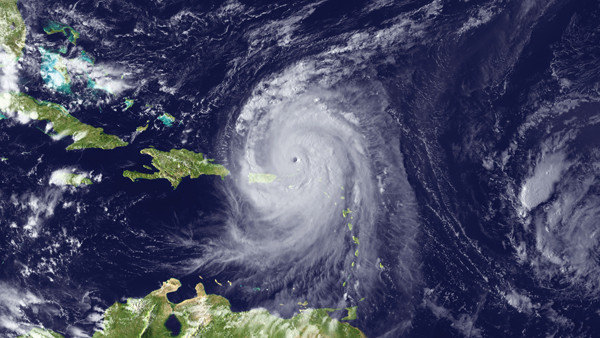
by Timothy Oleson Monday, April 15, 2013

Hurricane Earl passes over the Caribbean on Aug. 30, 2010. That same day, scientists aboard a NASA research flight collected air samples from the upper troposphere above the storm to look for signs of life. NOAA
With cold temperatures, low humidity and high levels of ultraviolet (UV) radiation, conditions 10 kilometers above Earth’s surface may seem inhospitable. But next time you’re flying, consider this: The air outside your airplane window might be filled with an array of microscopic life that affects everything from weather and climate to the distribution of pathogens around the planet.
In the first detailed study of microbes in Earth’s upper troposphere, a group of scientists has found populations of bacteria that — although they don’t rival the size and diversity of microbial communities in the oceans, soils or air at Earth’s surface — are startling all the same. While participating in several NASA-sponsored research flights intended to study atmospheric conditions related to hurricanes, the scientists collected samples of airborne biomass — most at about 10 kilometers altitude above the Gulf of Mexico and the Caribbean Sea — near two late summer 2010 hurricanes, Earl and Karl.
Initially, the team didn’t know what it would find, says Athanasios Nenes, an atmospheric scientist at Georgia Tech and a co-author of the resulting study published in Proceedings of the National Academy of Sciences. Conventional wisdom held that if they found any biological particles at such lofty heights, most would be dead, Nenes says. “But what we ended up finding is that in the vicinity of the hurricanes we saw a lot of microbes. And … most of them were alive. That was something that was really surprising.”
Microscopic analyses revealed that each cubic meter of air contained an average of about 150,000 cells — mostly bacteria with a few fungal cells mixed in. In each sample, between 60 and almost 100 percent of the cells were still alive, suggesting that some of the 314 different bacterial taxa identified through genetic testing are better able to cope at high altitudes than previously thought, the team wrote.
The exact mechanics of how the bacteria are transported to the upper troposphere remain unclear, Nenes says, but the basic idea is that strong winds kick up a lot of bacteria — along with water vapor, dust and other particulates — from Earth’s surface. Large-scale convection during tropical storms and hurricanes can then carry this material from the surface higher up into the atmosphere.
The team found that the bacterial assemblage in each sample tended to reflect the recent history of the air mass from which it was collected. “If the hurricane was predominantly over the oceans … then basically you saw almost exclusively oceanic bacteria, while if the storm had passed through some kind of populated area, we even saw things like E. coli,” which commonly lives in humans and other land animals, Nenes says. This correlation reinforces “that basically what we’re seeing is due to the atmospheric transport during the storm.”
Microbial assemblages were also larger and more diverse in air sampled during and shortly after the passing of the hurricanes. However, a “core” group of 17 taxa was found in every sample, regardless of where or when it was collected, suggesting that these bacteria in particular might “have the right types of genes to allow them to survive … in the harsh conditions at the top of the troposphere,” Nenes says, perhaps for at least a week or two. Given the strong winds at that altitude, a week or two is easily long enough for the bacteria to be blown all around the planet, he says, meaning there are implications for the transportation of species from place to place, and potentially for the dispersion of diseases.
To see such large numbers of cells high in the atmosphere is indeed surprising, says Brent Christner, a microbiologist at Louisiana State University in Baton Rouge who was not involved in the study. Under stress from solar radiation and low humidity, “a microbe that’s airborne is in a race against time,” Christner says. But if it can survive in the atmosphere, he says, “for a microbe, it’s a really efficient way to disperse.”
Some microbes might also act as nuclei on which water vapor can condense to form ice crystals, clouds and perhaps precipitation, Nenes says. At about one micron across, they’re the right size. And similar to dust and other nonliving particles that are known to nucleate ice and cloud formation in the atmosphere, some bacteria have been found to seed ice crystallization very effectively. Given the right bacteria and the right conditions in the atmosphere, “they could affect the cloud properties quite dramatically,” he says, especially in the upper troposphere where, according to his team’s results, bacteria account for an average of 20 percent of the large particulate matter in the airmasses sampled.
If there are live microbes in the upper troposphere, “that’s information that we need to know,” Christner says. “We need to know what players are involved, and work like this is giving us a good idea of [that].” Although the group’s data don’t show how these microbes are affecting cloud chemistry, or which taxa, if any, might act as nuclei, Christner points out, the study is a good starting point.
Note: After initial publication of this study, a letter by researchers raising questions about its methods and conclusions as well as a response by the study’s authors to the letter were subsequently published online by PNAS.
© 2008-2021. All rights reserved. Any copying, redistribution or retransmission of any of the contents of this service without the expressed written permission of the American Geosciences Institute is expressly prohibited. Click here for all copyright requests.